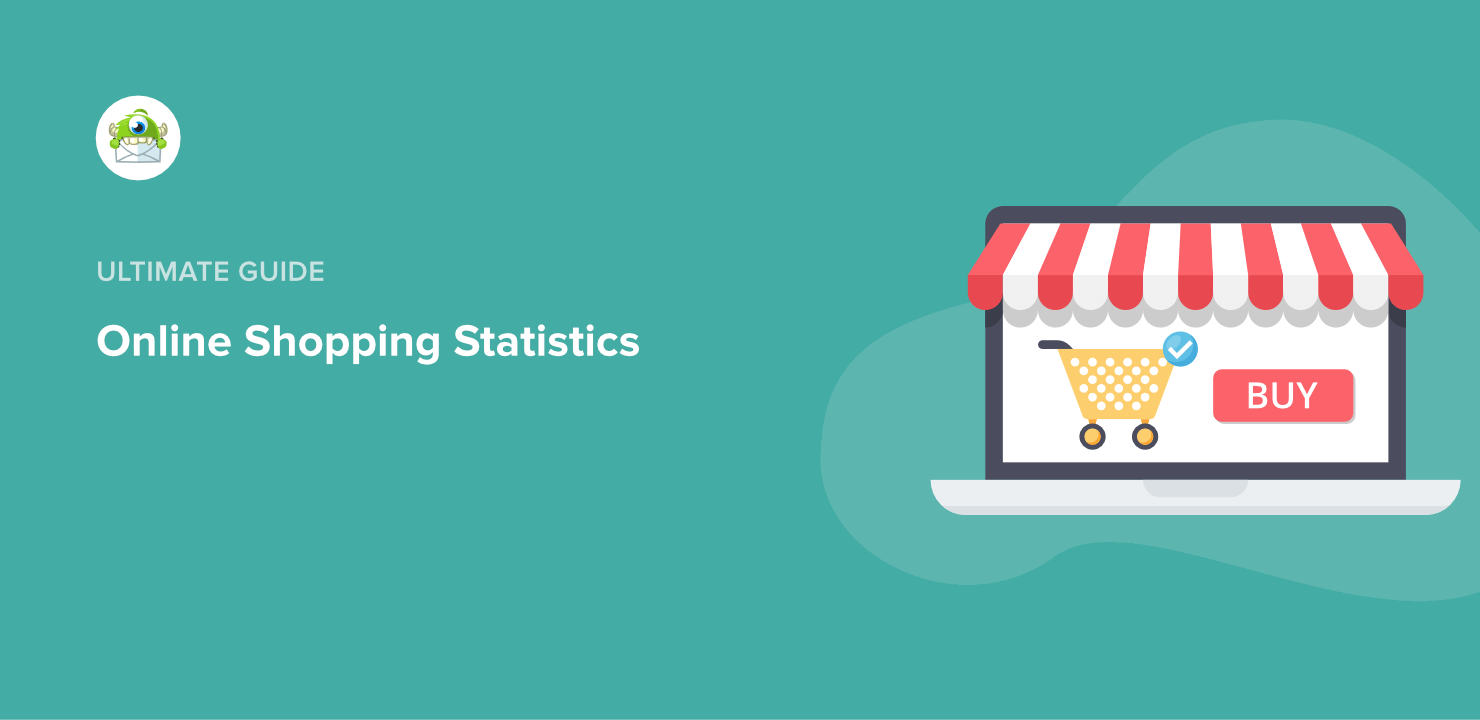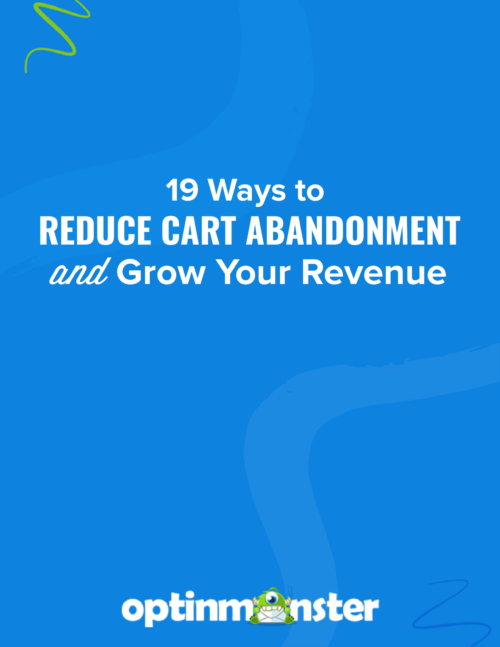In this guide, we’ll break down the most important online shopping statistics for 2025, including cart abandonment trends, Gen Z buying power, mobile habits, and how you can optimize your store to turn browsers into buyers.
How We Collect Our Data
We source all statistics in this post from trusted industry leaders like Statista, eMarketer, Shopify, Baymard Institute, and Juniper Research. When possible, we also use anonymized insights from OptinMonster customer data.
Our editorial team reviews and updates this post every 6–12 months to ensure accuracy. We prioritize data published between 2023–2025 and only include research that helps marketers make smarter, conversion-focused decisions.
- General Online Shopping Statistics
- eCommerce Store Statistics
- Mobile eCommerce Statistics
- Online Shopping Cart Abandonment Statistics
- Technology and AI in eCommerce Statistics
- Black Friday and Cyber Monday Statistics
- Gen Z and Social Commerce Statistics
- Payment and Checkout Statistics
- Emerging eCommerce Trends
🛒 Boost Your Online Sales with OptinMonster!
The latest online shopping statistics prove it—more people are buying online than ever! But are you capturing and converting your visitors into loyal customers? With OptinMonster, you can increase sales with high-converting popups, exit-intent discounts, and smart targeting.
✅ Reduce cart abandonment with personalized offers
✅ Grow your email list with exclusive shopping deals
✅ Boost conversions with time-limited promotions
💡 Pro Tip: Use OptinMonster’s exit-intent technology to recover abandoning shoppers and turn them into buyers before they leave!
🎯 Start increasing your online sales today! Try OptinMonster Now →
General Online Shopping Statistics
Key Statistics (2025)
- Global eCommerce sales are expected to reach $6.86 trillion in 2025, up from $6.3 trillion in 2024.
- Around 2.8 billion people worldwide will make at least one online purchase this year.
- Online sales now represent about 22% of total global retail, compared to 19% in 2022.
- The Asia-Pacific region continues to lead global online sales, with strong growth in emerging markets such as India and Indonesia.
- The average online order value increased by 7% year-over-year, reflecting stronger consumer confidence and broader product variety.
What These Numbers Tell Us
Online shopping is no longer a growth story; it has become a dominant force in global retail. The annual increases are smaller than in the early pandemic years, but the base is much larger. What we are seeing now is market maturity rather than market saturation. Consumers have integrated online shopping into their everyday habits, from groceries to high-ticket electronics.
The steady rise in the share of retail spent online shows how digital commerce has become the default mode of buying for many categories. While growth rates have slowed, the consistency indicates stability and resilience even in uncertain economies. Regions like Asia-Pacific and Latin America are driving much of the new demand, while North America and Europe are focusing on improving customer experience and retention.
Implications for Businesses
For brands and retailers, this shift means the focus must move beyond “being online” to “performing online.” Success in 2025 depends on conversion optimization, trust-building, and speed. Websites that load faster, offer seamless checkout, and demonstrate clear pricing transparency are capturing the bulk of this $6.86 trillion opportunity.
Summary: In 2025, over 2.77 billion people shop online globally, with eCommerce sales projected to exceed $6.86 trillion.
eCommerce Store Statistics
Key Statistics (2025)
- There are an estimated 26 to 30 million eCommerce stores worldwide, according to 2025 research from Red Stag Fulfillment and other global analyses.
- Fewer than one million online stores generate meaningful annual revenue, illustrating how competitive and fragmented the eCommerce landscape has become.
- Shopify powers over 4.8 million active stores, while WooCommerce and Wix eCommerce continue to dominate small-business adoption.
- About 22% of all new websites launched in 2024 included an eCommerce component such as a cart or checkout function, reflecting how store functionality has become a standard part of modern website builds.
- The average online retailer sells through three or more channels, combining their own site, marketplace listings, and social commerce platforms to reach more customers.
What These Numbers Tell Us
The global eCommerce ecosystem has reached a point of oversaturation. While the barriers to entry are lower than ever, the barriers to profitability are rising. Millions of new stores appear each year, but only a small percentage sustain consistent traffic or revenue. This uneven distribution mirrors the “winner-takes-most” reality of modern retail: top-performing brands attract the majority of customer attention and sales, while smaller stores struggle to differentiate themselves.
Platform diversity also signals a new reality. Sellers are no longer confined to a single storefront. Instead, they are spreading visibility across ecosystems, such as, their website for branding, Amazon for reach, and social channels for discovery. This omnichannel presence is now the default approach for retailers who want both control and scale.
Implications for Businesses
Competing in 2025 requires more than setting up an online store. Retailers must focus on brand positioning, niche targeting, and customer experience. The stores that thrive will be those that clearly define their audience, offer unique value, and integrate their marketing across multiple touchpoints. Technical optimization, trust signals, and personalized engagement are no longer optional; they are the minimum standards for staying competitive in a crowded digital marketplace.
Summary: There are over 28 million eCommerce stores worldwide in 2025, with Amazon, Walmart, and eBay leading the market by traffic and sales.
Mobile eCommerce Statistics
Key Statistics (2025)
- Mobile commerce is projected to account for 46% of all online sales in 2025, totaling roughly $3.2 trillion globally.
- About 70% of smartphone users who made a recent in-store purchase first used their device to research the product, according to Google’s Think with Google consumer behavior study.
- Mobile conversion rates remain lower than desktop, averaging 1.6% on mobile vs. 2.8% on desktop based on Statista’s global conversion benchmarks.
- About 52% of users say a bad mobile experience makes them less likely to engage with a brand.
- In the United States, mobile commerce is expected to make up 44% of e-commerce sales by 2025, according to VennApps’ compilation of 2025 mobile commerce data.
What These Numbers Tell Us
Mobile has become the default platform for online browsing and an increasingly important channel for conversions. Shoppers no longer distinguish between “mobile” and “desktop” experiences, they expect every site to be fast, intuitive, and personalized on any device. The fact that nearly half of all online sales now come from mobile shows how buyer behavior has fully shifted to convenience-first decision-making.
Despite this growth, the gap between browsing and buying remains significant. Lower conversion rates suggest that many mobile sites still struggle with usability issues: clunky menus, slow pages, and lengthy forms. The mobile shopper’s tolerance for friction is extremely low, and even minor frustrations often lead to abandonment.
Implications for Businesses
To capture mobile revenue, businesses must design for mobile intent rather than treating it as a smaller version of desktop. That means prioritizing fast load times, simplified navigation, larger tap targets, and express checkout options such as Apple Pay or Google Pay. Brands that invest in mobile-first optimization see stronger engagement, higher conversion rates, and better visibility in search results. In 2025, mobile performance is not just a technical concern, it is a competitive advantage.
Summary: Mobile commerce is expected to generate $2.51 trillion in 2025, with smartphones driving more than 60% of online purchases.
Online Shopping Cart Abandonment Statistics
Key Statistics (2025)
- The average global cart abandonment rate is 69.8%, meaning nearly seven in ten shoppers leave before completing their purchase.
- On mobile devices, the abandonment rate increases to approximately 85%, making mobile checkout the most common drop-off point in the purchase journey.
- The top reasons shoppers abandon carts include:
- Unexpected extra costs such as shipping or taxes (48%)
- Forced account creation (24%)
- Complicated or lengthy checkout processes (17%)
- Concerns about payment security (18%)
- Offering guest checkout can reduce abandonment by up to 35%, while displaying shipping costs early in the process can significantly lower drop-offs.
What These Numbers Tell Us
Cart abandonment continues to be one of the biggest revenue leaks in eCommerce. The data shows that most shoppers who add items to their carts have clear purchase intent, yet a combination of friction, surprise fees, and distrust leads them to exit before payment. This highlights a key truth: convenience and transparency matter more than persuasion at the final step of the buying process.
Mobile shoppers in particular are more likely to abandon their carts because of small usability issues that interrupt their flow. Every additional step or required field adds resistance, and even minor delays can disrupt the impulse to buy. These behavioral trends reveal that the challenge is rarely demand, it is the buying experience itself.
Implications for Businesses
Improving checkout flow is one of the fastest ways to increase conversion rates. Businesses should minimize the number of form fields, enable guest checkout, and show all costs upfront. Clear progress indicators and recognizable payment options can further reduce hesitation. Trust badges, SSL certification, and transparent refund policies also play a role in reinforcing security. In 2025, reducing cart abandonment is less about adding incentives and more about removing friction from the user journey.
Summary: The global cart abandonment rate remains high at 69.99%, with extra costs, account requirements, and slow shipping as top reasons.
Technology and AI in eCommerce Statistics
Key Statistics (2025)
- More than 40% of retailers are already using AI tools for personalization, pricing, and logistics, according to NVIDIA’s State of AI in Retail 2024 report.
- AI-powered product recommendations can increase average order value by 15–25%, as reported in Shopify’s insights on AI adoption in eCommerce.
- Nearly 63% of organizations using generative AI report revenue uplift within deployed business units, based on McKinsey’s State of AI 2024 report.
- Voice-assisted shopping still represents less than 10% of total online sales, though usage continues to grow in electronics and home categories.
- Retailers investing in predictive analytics have reported up to a 20% improvement in customer retention, according to McKinsey’s marketing analytics analysis.
What These Numbers Tell Us
AI is no longer an experimental technology in eCommerce; it has become part of everyday operations. Retailers are increasingly using machine learning to anticipate customer needs, optimize marketing campaigns, and manage inventory. The shift from reactive to predictive data use means that online stores are becoming more proactive in guiding customers toward what they are most likely to buy.
The data also shows that automation now extends beyond marketing into the customer experience itself. Chatbots, virtual assistants, and voice-enabled shopping are reshaping how people interact with online stores. Consumers have grown comfortable with personalized recommendations and fast, automated responses, as long as these tools feel natural and genuinely helpful.
Implications for Businesses
Retailers that strategically implement AI can gain measurable performance advantages. Personalization engines can increase conversion rates, reduce return rates, and improve repeat purchase behavior. However, automation should not come at the expense of authenticity. Overreliance on generic AI-generated messaging can erode brand trust. Businesses should aim for a hybrid model: automation for efficiency and human oversight for tone and empathy. In 2025, the best-performing eCommerce brands are those that blend intelligent technology with human understanding.
Summary: AI chatbots and voice assistants are becoming mainstream, with 47% of consumers open to using them for online purchases.
Black Friday and Cyber Monday Statistics
Key Statistics (2025)
- Black Friday 2024 in the U.S. generated $10.8 billion in online sales, a ~10% increase from the year before.
- Cyber Monday 2024 recorded $13.3 billion in online spending, setting a new record for the largest single day of online sales in history.
- Mobile devices accounted for 57% of all Cyber Monday purchases, surpassing desktop for the first time, according to Adobe’s official Digital Economy Index data.
- Average discounts ranged from 25% to 30%, with electronics, apparel, and home goods leading all categories.
- Email and push notifications accounted for nearly half of all online orders during Cyber Week 2024, outperforming both social media and paid search in conversion rates, according to Salesforce’s Holiday Shopping Trends 2024 report.
What These Numbers Tell Us
Black Friday and Cyber Monday remain critical events for online retailers, but the nature of these shopping days has evolved. The data shows a clear shift toward mobile-first buying and longer promotional periods. Instead of a single day of high-intensity sales, many brands now spread offers over several weeks to manage logistics and capture early shoppers. This approach aligns with changing consumer behavior, as buyers are increasingly motivated by convenience and early access rather than deep last-minute discounts.
The dominance of mobile purchases and the growth of pre-sale engagement channels, such as email and social media, highlight a maturing audience that plans ahead. Shoppers no longer wait for a single discount window; they expect personalized offers throughout the season. This trend reduces the “rush” effect of Cyber Monday but increases total revenue spread over a longer timeframe.
Implications for Businesses
Retailers should treat BFCM as a campaign season rather than a single event. Building momentum through segmented email lists, early sign-up incentives, and mobile-first optimization can significantly boost performance. Inventory management and logistics preparation are equally crucial, as shoppers expect fast delivery even during peak demand. Finally, post-sale engagement such as loyalty offers and retargeting helps convert one-time deal seekers into repeat customers. The most successful brands in 2025 are those that treat BFCM not as a flash sale, but as a long-term customer acquisition opportunity.
Summary: Black Friday and Cyber Monday remain peak online shopping events, with over $8.9 billion in online spending and mobile driving 53% of sales.
Gen Z and Social Commerce Statistics
Key Statistics (2025)
- There are an estimated 60% of Gen Z shoppers discover products through TikTok, Instagram, or YouTube before visiting an online store, showing how discovery now starts on social platforms.
- About 37% of Gen Z consumers in the U.S. have made at least one direct purchase through a social media platform, a signal that social commerce is rapidly becoming mainstream.
- Global social commerce sales are projected to hit $1.2 trillion in 2025, reflecting explosive growth from earlier years.
- Live shopping adoption exceeds 40% in China, where influencer-led retail has become a dominant part of the eCommerce ecosystem.
- Nearly 70% of Gen Z shoppers trust creator or influencer recommendations more than brand advertisements, emphasizing the importance of authenticity in online marketing.
What These Numbers Tell Us
Gen Z has redefined how products are discovered, evaluated, and purchased. This generation treats social platforms not just as entertainment but as search engines and marketplaces. Product discovery often begins with video content, reviews, tutorials, or influencer mentions and leads directly to purchase decisions without traditional website browsing. The social feed has effectively replaced the storefront window.
Trust plays a crucial role in this model. Gen Z’s skepticism toward traditional advertising has accelerated the rise of creator-led marketing. The line between social interaction and commercial intent is now blurred; shopping happens in the same spaces where users connect with peers. For businesses, this behavior marks a shift from keyword-driven search marketing to community-driven brand discovery.
Implications for Businesses
Retailers targeting Gen Z must invest in authentic, platform-native content. Traditional ad formats are less effective than short-form videos, user-generated content, and influencer collaborations. Integrating direct shopping features on social channels, such as TikTok Shop or Instagram Checkout, reduces friction and increases impulse buying. Brands should also develop creator partnerships that prioritize transparency and relatability over polished promotion. In 2025, social commerce is not a side channel but it is a core part of the eCommerce funnel, especially for emerging audiences.
Summary: Gen Z will soon control 40% of all consumer spending, with 95% using smartphones and 85% discovering products via social media.
Payment and Checkout Statistics
Key Statistics (2025)
- Digital wallets now account for approximately 54% of all online payments worldwide, surpassing credit and debit cards as the most common payment method.
- Buy Now, Pay Later (BNPL) services are used by about 20% of U.S. online shoppers, with higher adoption among millennials and Gen Z consumers.
- PayPal, Apple Pay, and Google Pay remain the top three payment options globally, while regional wallets such as Alipay and Paytm continue to dominate in Asia.
- Retailers offering one-click checkout report an average 35% higher conversion rate than those using traditional multi-step processes.
- Sites that display security badges, SSL certificates, and transparent refund policies reduce checkout abandonment by up to 20%.
What These Numbers Tell Us
The way consumers pay online continues to evolve toward convenience, speed, and perceived security. Digital wallets have overtaken traditional cards because they minimize friction, particularly on mobile devices. BNPL adoption also reflects shifting consumer preferences: shoppers are increasingly seeking flexibility without relying on revolving credit. This trend highlights how payment options directly influence both trust and conversion rates.
The dominance of PayPal and mobile wallets underscores a growing expectation for instant, low-effort transactions. Shoppers are far less tolerant of lengthy forms or uncertain payment experiences. Security remains a deciding factor. Visible trust signals and reliable refund policies help convert hesitant buyers, especially on first-time purchases. In eCommerce, perceived safety is often as important as the actual transaction process.
Implications for Businesses
Retailers should prioritize offering multiple, modern payment options that match customer expectations. Integrating popular digital wallets and BNPL solutions can expand conversion potential, especially among younger demographics. Streamlined checkout flows and clear payment icons reinforce confidence and reduce drop-offs. As competition intensifies, the checkout experience has become a direct reflection of brand trust. In 2025, payment convenience and transparency are as essential as product quality in driving online sales.
Summary: Credit/debit cards and digital wallets dominate online payments in 2025, while buy-now-pay-later and crypto gain traction among younger shoppers.
Emerging eCommerce Trends
Key Statistics (2025)
- 68% of global consumers say they are more likely to buy from brands that use sustainable packaging or demonstrate environmentally conscious practices.
- The augmented reality (AR) shopping market is expected to grow by over 40% year-over-year, particularly in fashion, beauty, and home goods.
- Subscription commerce is projected to reach $38 billion globally in 2025, driven by categories such as personal care, pet products, and specialty foods.
- One in four shoppers now makes cross-border purchases, with Asia-Pacific and Europe leading international order volume.
- AI-driven personalization and product recommendations are estimated to influence over 50% of all online purchases, according to recent market studies.
What These Numbers Tell Us
The latest trends show a clear shift in consumer priorities: sustainability, personalization, and convenience are now defining factors in online shopping. The growing interest in eco-friendly products and packaging reflects a deeper cultural shift toward responsible consumption. Shoppers increasingly view environmental values as part of brand identity rather than a bonus feature.
At the same time, technological advancements like augmented reality are transforming how customers evaluate products before purchase. Virtual try-ons, 3D previews, and immersive product experiences reduce uncertainty and returns while increasing engagement. Subscription models also continue to expand as consumers embrace predictable, curated purchasing experiences that fit into their daily routines.
Implications for Businesses
Retailers should align their strategies with these evolving expectations. Highlighting sustainable sourcing, offering carbon-neutral shipping options, and communicating environmental impact transparently can strengthen trust and loyalty. Investing in AR features or interactive product displays enhances confidence and conversion rates, especially for categories that rely on visual detail. Subscription offerings can improve customer lifetime value and create predictable revenue streams.
In 2025, eCommerce success depends not only on convenience but also on alignment with consumer values. Brands that demonstrate authenticity, sustainability, and innovation are best positioned to earn long-term loyalty in an increasingly competitive market.
Improve Your Stores Shopping Experience with OptinMonster
All online stores rely heavily on generating leads via popups. OptinMonster is the most powerful conversion optimization tool and email popups creator in the world because:
- OptinMonster’s powerful drag-and-drop builder allows you to create visually stunning optin forms optimized for the highest conversion rates.
- You can choose from the perfect campaign type to display the most attention-grabbing offers to your visitors for maximum engagement.
- You can detect your visitors’ shopping behavior and use smart triggers to display the right campaign to the right person at the right time.
- It allows you to use precision targeting to create campaigns that generate more leads, attract more subscribers, and increase total retail sales.
- You can create campaigns that react and adapt in real-time so you can easily personalize, segment, and target for incredible conversions.
- You can get the stats that matter and the tools you need to take action and improve your lead-generation strategy.
Frequently Asked Questions
Q1: How many people shop online in 2025?
Approximately 2.8 billion people worldwide make at least one online purchase each year. This means nearly one in three individuals across the globe engages in eCommerce activity. The figure reflects both increased internet accessibility and a growing comfort with digital transactions in emerging markets.
Q2: What percentage of total retail sales come from online shopping?
As of 2025, around 22% of global retail sales occur online. While growth has slowed compared to the pandemic years, the share continues to rise steadily. This trend shows that online shopping has become a permanent and integrated part of the retail landscape rather than a temporary shift.
Q3: Why do so many shoppers abandon their carts before completing a purchase?
The most common reasons include unexpected extra costs, forced account creation, and complicated checkout forms. These pain points disrupt the buyer’s momentum. Improving transparency and offering guest checkout options remain two of the most effective solutions to reduce abandonment.
Q4: Which devices do people use most for online shopping?
Smartphones account for nearly half of all online purchases globally. Mobile shopping dominates discovery and browsing, especially for impulse or repeat purchases. However, desktop still leads slightly in conversion rates due to ease of form entry and multi-tab comparison behavior.
Q5: What payment methods do shoppers prefer?
Digital wallets such as PayPal, Apple Pay, and Google Pay have become the most popular online payment methods, used in over half of all transactions worldwide. Their growth is driven by convenience and built-in security. Consumers expect quick, secure, and flexible payment options across all devices.
Q6: What trends will shape online shopping in the future?
Expect stronger integration of AI-driven personalization, wider adoption of sustainable retail practices, and continued growth of social commerce and mobile-first experiences. Consumers are increasingly seeking relevance, trust, and transparency from brands, and the businesses that deliver these qualities consistently will set themselves apart.
Also checkout:
- Ecommerce Growth Statistics: Key Insights Every Business Should Know
- Shopify CRO: How To Make More Sales From Your Current Traffic
- Content Marketing Statistics: Everything You Need To Know
- 40+ Email Marketing Statistics You Need to Know
- 95+ Mind-Blowing Digital Marketing Statistics to Learn From
- Ultimate List of Blogging Statistics and Facts











Add a Comment